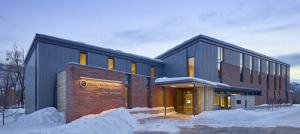By Cutright Elizabeth on October 5, 2016 in Technology
Touted as the one of the nation’s most energy efficient structures, the Rocky Mountain Institute’s new headquarters doesn’t just survive Colorado’s harsh winters – it thrives.
With nighttime temperatures hovering around 5 degrees Fahrenheit in the winter, and an average of 90 inch es of snow per year, Basalt, Colorado may not seem like the ideal spot for one of the world’s most energy efficient buildings. That didn’t stop the Rocky Mountain Institute (RMI) from choosing a new location along the Basalt’s Roaring Fork River for their new headquarters. With neighbors like Aspen and Snowmass, RMI’s property shines like a beacon amidst snowcapped mountains and knee-high drifts, but it’s the 252 days of sunlight per year that help this architectural set piece maintain 60-degree indoor temperatures even during the coldest night of the year.
es of snow per year, Basalt, Colorado may not seem like the ideal spot for one of the world’s most energy efficient buildings. That didn’t stop the Rocky Mountain Institute (RMI) from choosing a new location along the Basalt’s Roaring Fork River for their new headquarters. With neighbors like Aspen and Snowmass, RMI’s property shines like a beacon amidst snowcapped mountains and knee-high drifts, but it’s the 252 days of sunlight per year that help this architectural set piece maintain 60-degree indoor temperatures even during the coldest night of the year.
The surrounding ski resorts actually helped inspire the building’s structure. As Justin Brooks, lead designer ZFG Architects explains in an interview with Gizmodo, “It’s a very Colorado Solution. If you’re wearing a down jacket that’s highly insulated on the back, you can still sit outside and enjoy a beer.”
RMI’s building follows similar logic. The building capitalizes on all those sunny days by using airflow, directed ventilation and solar panels to capture the solar gain from the south side of the building – which gets the most direct exposure to sunlight – and use it to manage the temperature inside. Rooftop solar panels and high-performance quad-pane windows also do their part, the former contributing to the structure’s power load and the latter trapping thermal energy.
The building’s exterior also contributes, with a “super tight” building envelope and sunshades on the façade that move based on weather sensor data. Kinetic and responsive, the outside of the building excels at controlling glare and managing temperatures inside.
“I often find myself forgetting that it’s a state-of-the-art net-zero energy building until I see our exterior sunshades automatically going down to guard the building from solar heat gain on hotter afternoons,” said Kelly Vaughn, marketing manager at RMI. “It’s a very visual reminder that we are quite literally being heated by the sun!”
The building eschews central heating by funneling heated air to populated areas and using heated workstation floor mats to provide individual temperature control.
“We saw we could bring the heat to where the people are,” Brooks tells Gizmodo. “Not the other way around.”
Specialized drywall enhanced by special wax material that traps and releases heat works in concert with concrete slabs to consolidate thermal energy – creating what Brooks calls a “thermal battery.” Those low-wattage electric floor mats keep individual workstations toasty, and though the building has a radiant heating system in the floors, RMI has yet to use it.
Similar in size to most commercial buildings in the US, its RMI’s location that makes it stand out as one of the most energy-efficient buildings situated in North America’s coldest climate zone. Because the construction uses 74 percent less energy than similar despite its surroundings, it demonstrates how sustainable design is possible even in the harshest environments. For RMI’s Cara Carmichael, who served as project manager during development, the building’s $13.6 million cost – only 10% higher than traditional business offices – presents a compelling argument that “Net Zero isn’t that much more expensive” for commercial developers.
For Brooks, RMI’s headquarters has value beyond its sustainability as a tool to educate and promote environmentally friendly architecture.
“A key point of the building is that the design elements that make it beautiful are what allows it to perform,” Brooks explains. “The building is intended to uplift, to help inform, and to teach.”
“We think this building can really inform the industry,” Carmichael tells Architecture Magazine. “We designed it for this particular location and climate. If you picked it up and moved it to Florida, it wouldn’t work. But we hope to inspire people to put the same thought and care into designing their own sustainable office buildings.”


